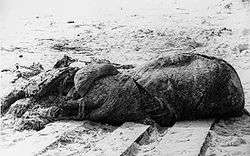Lusca

The lusca is a name given to a sea monster reported from the Caribbean. It has been suggested by cryptozoologists that the lusca is a gigantic octopus, far larger than the known giant octopuses of the genus Enteroctopus.
Sightings
Many reports of the creature are from the blue holes, off Andros, an island in the Bahamas. The St. Augustine Monster (an example of a globster), which washed up in 1896 on the Florida coast, is considered one of the better candidates for a possible lusca specimen. Recent evidence suggests the St. Augustine Monster, like many globsters, was simply a large mass of decomposing adipose tissue from Sperm Whale. Scientists dismiss the lusca as at most a large example of the giant squid.
On January 18, 2011, the body of what appeared to witnesses to be a giant octopus washed ashore on Grand Bahama Island in the Bahamas. According to eyewitness reports, the remains seemed to represent only a portion of the head and mouthparts of the original creature. Based on their knowledge of octopus morphology, local fishermen estimated the total size of the creature when living to be some 20 to 30 feet.[1]
Description
The lusca is said to grow over 75 ft (23 m) long, or even 200 ft (60 m) long, however there are no proven cases of other octopus species growing up to even half these lengths. To attack properly on the surface, the octopus would have to have one tentacle on the sea floor to balance itself; this would mean that such accounts, if real, would have to take place in relatively shallow water. Other descriptions also mention that it can change color, a characteristic commonly found in smaller octopuses. The supposed habitat is rugged underwater terrain, large undersea caves, the edge of the continental shelf, or other areas where large crustaceans are found, which is supposedly what they feed on. Although the general identification of the lusca is with the colossal octopus, it has also been described as either a multi-headed monster, a dragon-like creature, or some kind of evil spirit.
In Popular Culture
The reports of the Lusca Monster attacking swimmers and divers was investigated by Jeremy Wade, the host of the television series River Monsters, in the episode "Terror in Paradise" (Season 8, Episode 4). After investigating reef sharks, tiger sharks, and some fish species Jeremy settled on a large octopus being the most likely culprit for being the Lusca Monster. [2]
See also
- Bloop
- Chickcharney, another cryptid from Andros
- Giant squid
- Globster
- Trunko
References
- ↑ Noel, G. 2011. Octopus remains washed ashore. The Freeport News, January 19, 2011.
- ↑ River Monsters: Terror in Paradise, Pink Ink, May 5th 2016
- John Moore. "The St. Augustine Giant Octopus". STRANGE MAGAZINE Online.